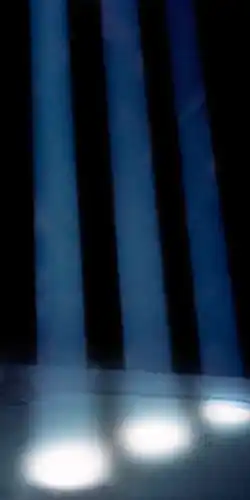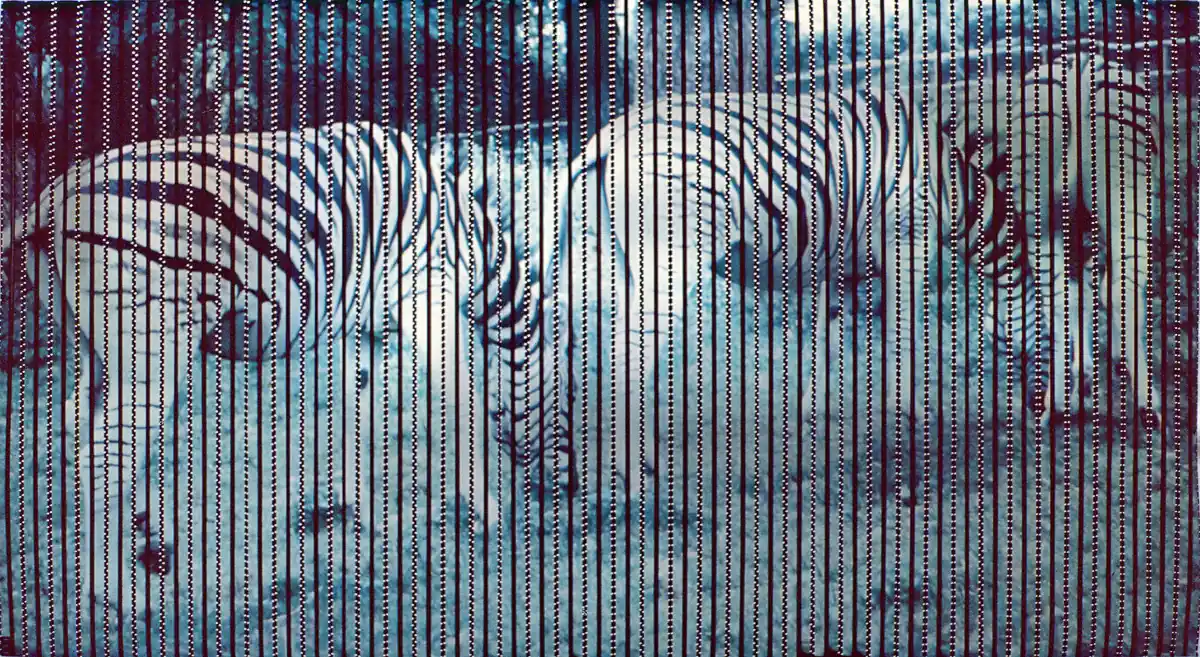BLACK & LIGHT
Produced in 1974, through a diverted use of computer equipment, at the dawn of the era of digital pictures.
7’48’’ sound

(Black & Light – © Pierre Rovere)
► Grand prix du film abstrait award, Montpellier 1974.
► Diploma of Excellence, 5th International 16mm Film Festival, Montreal 1975.
Pictures and sound are produced without any film equipment but through the diverted use of computer equipment dating back from the early 60s. In its original version, this film is probably the only one in cinema history to be in absolute black and white. Absolute black is achieved through the use of a 100% opaque tape (diverted use of 16 mm magnetic tape or exposed very high contrast film). Absolute white is obtained by perforating the tape (thus allowing 100% of available light to pass through).
In fact, originally, no copy was made in a movie-lab. Each release was a unique computer-generated output, slightly different from the previous one because of a slender random shift that took place during the perforation of the 16 mm film. Six(?) original releases had been initially generated, of which only three or four remain.
The film has been shown via three different media:
- screening in theatres,
- vertical projection in a fog box exhibiting the movement of the beams,
- as a “cinegraphic-frame” also called “structure”.
Vertical projection in a fog box.
Faisceaux Black and Light: device created as part of an “installation” at the Musée National d’Art Moderne – Centre Georges Pompidou, from 10 to 21 January 1979.


IRIS
Produced in 1976, through a non-compliant process in a movie laboratory.
9’23’’ sound

(Iris – © Pierre Rovere)
The base sequence of Iris is a constructed cycle of coloured events, followed by its copy, chromatically inverted in the movie laboratory. This standard sequence is then again inverted-copied, and so on, inverted copy of the inverted copy, from generation to generation. Each sequence of inverted copies is, according to established standards, a deterioration. Looking at it more closely, this successive process enriches the image. The resulting experience is quite exciting.
This artwork falls between an identical repetition and the twofold process of degradation-complexification of photographic material. ¹
¹ P.H. L’art du mouvement – Collection cinématographique du Musée national d’art moderne, catalogue under the direction of Jean-Michel Bouhours, Éditions du Centre Pompidou, Paris 1996, p391
The sound, created on a frequency synthesizer (oscillators and filters), punctuates the changeovers of inverted copy sequences.
ZÈBRES
Produced in 1978, without a camera nor any cinematographic equipment
6’38’’ silent

(Zèbres – © Pierre Rovere)
A photographic image of three zebras, their graphics and their environment, generate the frames of this film, which once screened, is neither a representation of the zebras nor a continuity of movement, but a succession of isolated effects that seem random although they are the result of a perfectly structured photographic picture. The zebras are not the film (they are not seen in the projected film), but they are the structure of the film, that is to say its “score” (which generates the sequence of film frames).
The film is presented both in scroll (screening) as well as in the form of its “cinegraphic frame”, also called “structure”. Here, it is the cinegraphic frame that is at the origin of the film and not the other way round.

inTO
Achieved by oblique use of the Telidon videotex system.
1’02’’ silent
inTO : a squared multiplication.
Produced with Telidon, a Canadian videotex system that was in use in the 1980s. Although its primary function was to transmit textual and illustrative information, this system has been used by a number of Canadian artists as a creative tool to make graphic or video work.
This film, like the three others made by Rovere with this technology, possess the rudimentary and primitive charm of the beginnings of the digital image era.
From the mid-1970s to the mid-1980s, Rovere’s artistic approach led him to favour experimental cinema (16mm film, analogue video, computer-generated images).
This “cinefolio” (or film portfolio) is not intended to be exhaustive, but only to give an overview of the spirit of his approach through his most significant works. However, most of his films are in the catalogue of Lightcone.
They can also be found in the catalogue of cinedoc-ParisFilmsCoop.
